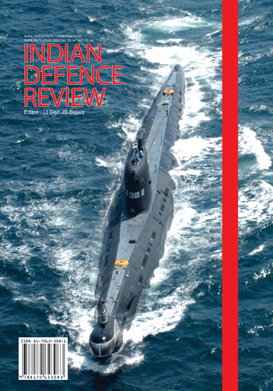NCW allows us to move from an approach based upon the massing of forces to one based upon the massing of effects. This allows us to reduce our battle space footprint which, in turn, reduces risk because we avoid presenting the enemy with attractive high value targets. Empowered with knowledge derived from a shared awareness of the battle space and a shared understanding of the Commander’s intent, our forces can display initiative to meet the Commander’s intent and be more effective when operating autonomously. Increase in NCW capabilities will exponentially enhance RMA.
Globally, militaries have researched and considered RMA as an organisational concept…
Political Direction
Globally, militaries have researched and considered RMA as an organisational concept. The nations which have capitalised on RMA have possessed very strong and focused political direction and legislation to enforce systemized programmes for its implementation. Axiomatically, the infrastructure and investment demands are heavy and many countries have not invested required sums in defence, especially where the potential of RMA is not grasped by the establishment.
A successful revolution also requires key bureaucracies to possess certain institutional characteristics that enable them to direct technological advances to dramatically improve military efficiency and efficacy. Developed countries that have had exponential increase in RMA, have adopted a Top Down approach emanating from the political apex. They made organisational changes necessary to accelerate synergy in the Armed Forces. This despite critics pointing out that a ‘revolution’ within the military ranks might carry detrimental consequences, produce severe economic strain and ultimately prove counterproductive.
RMA in China
China is actively promoting RMA with Chinese characteristics and making focused advancements in national defence and armed forces modernisation. Top Chinese military and civilian officials have periodically affirmed the importance and relevance of RMA to China’s military modernisation. Inspired by the 1991 Gulf War and subsequent US actions in Kosovo, China is shaping the modernisation of the People’s Liberation Army in the context of global trends in military transformation. To some Western analysts, the Chinese RMA is limited to ‘pockets of excellence’ only, since large amount of weaponry and technology is still imported.
A successful revolution also requires key bureaucracies to possess certain institutional characteristics…
It would be prudent for India to take note and monitor the Chinese RMA experiment. Chinese military technologies and production capabilities are impressive. Massive technological progress has been realised in short span incorporating sophisticated foreign technology and enabling the PLA to take advantage of an RMA of leading foreign militaries. China has hitched its technological evolution to the global train by committing itself to a more open economy and breaking the paradox of the snail paced ‘self-reliance only’ concept.
In terms of field of force structuring, the PLA has achieved growth in asymmetric capabilities. They have invested heavily in submarines and guided missile destroyers to counter a probable US Carrier Battle Group in the stand-off against Taiwan, making sea capability the answer to a superior US forces sea control capability. The Chinese are not only investing in PLA and military hardware but in all aspects of Diplomatic, Information Operations, Military and Economic (DIME) including foreign governments in India’s immediate neighbourhood and the Indian Ocean Region.
The PLA is being ‘informised’, downsized and the older leadership is being replaced with a younger and more technological aware force. Thousands of all ranks are being put through advanced studies in RMA related subjects on a yearly basis. Specific appointments for General Officers are tenable by those having had tri-Service experience or satisfying laid down technological criteria. Other measures include advanced ICBMs, nuke delivery systems and an undeclared chemical weapons capability; advanced satellite and anti-satellite capabilities; extensive third dimension capability, Rapid Reaction Forces, expanding Blue Water Navy and a formidable Air Force; potent Cyber warfare capability, political will to use it and increasing offensive potential in this context; large chip manufacturing capability; ongoing organisational adjustments in addition to mere downsizing. Reorganised logistics organisations are being put in place; development of sub conventional/asymmetric warfare capabilities. Media reports of support to the ULFA (including Paresh Barua’s base in Chinese territory), Maoists in Nepal and many such measures are indicative of this.
It would be prudent for India to take note and monitor the Chinese RMA experiment…
RMA in the Indian Military
Our military requires organisational changes that are necessary to give an impetus to synergising the Armed Forces towards integration and achieving RMA. These changes have to be driven from the top political leadership of the country. In the USA, the catalyst for the transformation process commenced with former Secretary of Defence, Donald H Rumsfeld; the US Department of Defence created US Joint Forces Command as the transformation laboratory of the US Military to force the US Armed forces into jointness. The Goldwater Nichols Act brought about revolutionary changes in the US Armed forces, accelerating synergy and boosting RMA. In China, the change was ushered in by Jiang Zemin and its implementation overseen by the Central Military Commission and Chief of General Staff of the PLA. In Germany, the transformation process was initiated by the Berlin Decree which aimed to integrate the Armed forces ensuring reaping full benefits of ongoing technological advancements. The German Chief of the Defence Forces is overseeing the transformation of the Armed Forces in was appointed. In India, even a Chief of Defence Staff (CDS), though recommended by the Kargil Review Committee has yet to be appointed. Jointness in Services simply has to be forced from the top. Perhaps only an Act of Parliament can enforce this.
RMA can hardly be de-linked from the Indian State. Aside from lack of political direction, complete lack of military professionals in the MoD and the defence-industrial complex (DRDO-DPSUs-OF) has brought us to a sorry state, some of the indicators being – void of a National Security Strategy and Comprehensive Defence Review; the military lacks the required synergy including joint war fighting doctrine and organisations that facilitate implementing jointness. HQ IDS has not been integrated with the MoD and lacks operational responsibility and authority.
RMA can hardly be de-linked from the Indian State…
A CDS is yet to be appointed despite specific recommendations made by the Kargil Review Committee a decade ago. The Tri-Service NCW Doctrine and Enterprise NCW Architecture are yet to be evolved. Tri-Service net-centricity is absent. A large number of command and control equipment and networks are being established but lack common standards and protocols. Several inter-operability constraints exist both intra-Service and inter-Service. Long-range stand-off precision attack capability against land targets is limited though being built up; procurement of weapons platforms and equipment need to cater for technological adaptation; the ability of technological entities to be integrated for synergised joint operations and the scope for innovation.
Air Defence capability is limited and differences between the Services as to who controls the Air Space remain unresolved; establishment of army’s Tac C3I and TCS systems are inordinately delayed; no dedicated Defence Band has been allocated in the spectrum – adequate bandwidths are not available to exploit technology; development of HR for is largely being done on individual Service basis; Cyber Warfare capabilities in the Military and National level are at nascent stage with little offensive capability; no policy for countering asymmetric/fourth generation war has been evolved. National Information Grid is yet to be established and no national policy evolved for Employment of Special Forces strategically on politico-military missions; negligible indigenous chip manufacturing capability exists; enormous security vulnerabilities exist with practically all computer and communications equipment parts and large amount of hardware and software continues to be being imported while little capability exists for detecting and eliminating malware embedded at manufacturing stage, and defence imports continue at over 70 per cent though the new government is resolved to address the issue on priority.
An evolutionary approach that we have been following past decades can hardly suffice. At the National/Military level, we need to do the following – make a blueprint for RMA and legislate it through the Parliament as advanced countries have already done. The draft would need to be prepared by the Military integrating Diplomatic, Information Operations and Economic aspects; replace the MoD with a Department of Defence staffed by military professional directly under the PM; allocate Defence Budget in sync with the approved RMA blueprint, prohibiting the surrender of Defence Budget and permit carriage of unutilised funds to the next financial year; appoint a CDS with full operational powers without further delay; make jointness in the Services a fait accompli, initiating establishment of an Integrated Functional and Integrated Theatre Commands; charge the CDS to implement the RMA under the directions of the Prime Minister, including synergising military and developing NCW capacity; inject military professionals in DRDO-DPSU-OF at all levels including for management and decision making; evolve comprehensive policy for military diplomacy; allot a dedicated Defence Band from the spectrum considering the security requirements; establish a Cyber Command, develop offensive capabilities and make information dominance an integral part of the cyber warfare doctrine; enunciate a Policy for Countering Asymmetric/Fourth Generation War and a National Policy for Strategic Employment of Special Forces particularly for countering these forms of war; establish comprehensive indigenous modern chip manufacturing capability on fast track progressive basis; ensure self reliance in software, hardware, production of hardened active network components including storage area networks and in the interim develop testing capability for malware; focus efforts to achieve self-sufficiency in critical areas like space technology and development of modern weapon systems including comprehensive ‘System of Systems’; accelerate education and joint training of military personnel to support and promote the new RMA with Indian characteristics and speed up establishment of the Indian National Defence University (INDU) and ensure that our procurement process is able to absorb and leapfrog technology.
RMA in the Indian Military is ongoing but needs to be drastically focused and accelerated. The political hierarchy must enforce jointness in the military and ensure organisational changes that are necessary to give an impetus to synergising the Armed Forces into total integration. Advancements in military technology will enable military operations to be conducted with such speed, precision and selective destruction that the nature and way in which future wars are fought and their consequent political impact will fundamentally alter the way in which military and political affairs are conducted.
In order to respond to this imperative, as also to fully exploit the potential offered by these technologies, our organisation and processes, concerned with the whole business of producing military/security capability will need to be re-structured accordingly. We must be able to protect own information systems, attack/influence information system of adversaries and leverage own strengths to gain decisive advantage in a battle space where national security is threatened. Future threats require us to leapfrog into total transformation through the application of RMA.





